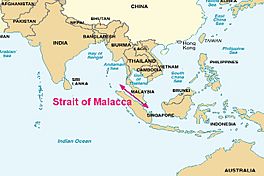Strait of Malacca facts for kids
Quick facts for kids Strait of Malacca |
|
|---|---|

The Strait of Malacca connects the Pacific Ocean to the east with the Indian Ocean to the west
|
|
| Location | Andaman Sea-Karimata Strait |
| Coordinates | 4°N 100°E / 4°N 100°E |
| Type | Strait |
| Native name | Malay: Selat Melaka Indonesian: Selat Malaka Thai: ช่องแคบมะละกา Tamil: மலாக்கா நீரிணை Chinese: 马六甲海峡 Error {{native name checker}}: list markup expected for multiple names (help) |
| Basin countries | |
| Min. width | 2.8 km (1.7 mi) |
| Average depth | 25 metres (82 ft) (minimum) |
| Settlements | Malacca City Port Klang Penang Medan Phuket Satun Province Singapore Aceh Riau |
The Strait of Malacca is a very important waterway located in Southeast Asia. It connects the Andaman Sea (part of the Indian Ocean) with the Java Sea (part of the Pacific Ocean). This makes it a key passage for ships traveling between the East and the West.
The strait is about 800 kilometers (500 miles) long. Its width changes, usually between 50 km and 300 km (30 to 185 miles). However, at its narrowest point, it is only about 2.8 kilometers (1.7 miles) wide. The shallowest part of the strait is about 25 meters (82 feet) deep.
Contents
Why is the Strait of Malacca Important?
The Strait of Malacca is one of the busiest shipping lanes in the world. Many ships use it every day. It is like a superhighway for cargo ships, oil tankers, and other vessels.
Global Trade and Shipping
This strait is vital for global trade. About one-quarter of the world's traded goods pass through it. This includes oil, natural gas, and manufactured products.
It is the shortest sea route between the Middle East, Europe, and East Asia. Without it, ships would have to travel much longer distances. This would make shipping more expensive and take more time.
Oil and Energy Transport
A huge amount of the world's oil supply travels through the Strait of Malacca. Tankers carry oil from the Middle East to countries in East Asia, like China, Japan, and South Korea.
Because so much oil passes through, the strait is very important for the energy security of many nations. Any disruption here could affect global oil prices and supplies.
Geography of the Strait
The Strait of Malacca is bordered by several countries. On its northeast side are Malaysia and Thailand. To the southwest is the island of Sumatra, which belongs to Indonesia. At its southeastern end is the island nation of Singapore.
Important Cities and Ports
Many important cities and ports are located along the strait. These include Malacca City and Port Klang in Malaysia, Medan in Indonesia, and the major port of Singapore. These cities play a big role in trade and shipping.
Challenges and Concerns
Even though the Strait of Malacca is very important, it faces some challenges.
Piracy and Security
Historically, piracy has been a problem in the strait. Pirates would attack ships to steal cargo or demand ransoms. Countries in the region have worked together to make the strait safer. They have increased patrols and improved security measures.
Environmental Issues
With so many ships passing through, there is a risk of environmental problems. Oil spills from accidents could harm marine life and coastal areas. Pollution from ships is also a concern.
Another issue is haze, which can come from forest fires in nearby regions. This smoke can reduce visibility for ships, making navigation more difficult and dangerous.
Narrow and Shallow Areas
The strait has some narrow and shallow parts. This can be tricky for very large ships, especially supertankers. They must navigate carefully to avoid running aground.
History of the Strait
The Strait of Malacca has been important for centuries. It was part of ancient trade routes, connecting civilizations from India, China, and the Middle East.
Merchants and explorers used the strait to exchange goods, ideas, and cultures. This long history shows just how vital this waterway has always been for connecting different parts of the world.
Images for kids
-
Yearly haze from the smoke of raging bush fires, limiting visibility.
See also
 In Spanish: Estrecho de Malaca para niños
In Spanish: Estrecho de Malaca para niños



